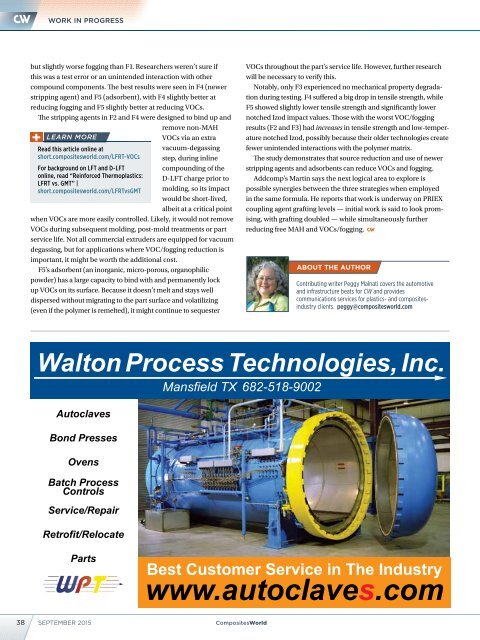FOR AUTO RTM
1VeKpGy
1VeKpGy
You also want an ePaper? Increase the reach of your titles
YUMPU automatically turns print PDFs into web optimized ePapers that Google loves.
WORK IN PROGRESS<br />
but slightly worse fogging than F1. Researchers weren’t sure if<br />
this was a test error or an unintended interaction with other<br />
compound components. The best results were seen in F4 (newer<br />
stripping agent) and F5 (adsorbent), with F4 slightly better at<br />
reducing fogging and F5 slightly better at reducing VOCs.<br />
The stripping agents in F2 and F4 were designed to bind up and<br />
remove non-MAH<br />
VOCs via an extra<br />
Read this article online at<br />
short.compositesworld.com/LFRT-VOCs<br />
For background on LFT and D-LFT<br />
online, read “Reinforced Thermoplastics:<br />
LFRT vs. GMT” |<br />
short.compositesworld.com/LFRTvsGMT<br />
vacuum-degassing<br />
step, during inline<br />
compounding of the<br />
D-LFT charge prior to<br />
molding, so its impact<br />
would be short-lived,<br />
albeit at a critical point<br />
when VOCs are more easily controlled. Likely, it would not remove<br />
VOCs during subsequent molding, post-mold treatments or part<br />
service life. Not all commercial extruders are equipped for vacuum<br />
degassing, but for applications where VOC/fogging reduction is<br />
important, it might be worth the additional cost.<br />
F5’s adsorbent (an inorganic, micro-porous, organophilic<br />
powder) has a large capacity to bind with and permanently lock<br />
up VOCs on its surface. Because it doesn’t melt and stays well<br />
dispersed without migrating to the part surface and volatilizing<br />
(even if the polymer is remelted), it might continue to sequester<br />
VOCs throughout the part’s service life. However, further research<br />
will be necessary to verify this.<br />
Notably, only F3 experienced no mechanical property degradation<br />
during testing. F4 suffered a big drop in tensile strength, while<br />
F5 showed slightly lower tensile strength and significantly lower<br />
notched Izod impact values. Those with the worst VOC/fogging<br />
results (F2 and F3) had increases in tensile strength and low-temperature<br />
notched Izod, possibly because their older technologies create<br />
fewer unintended interactions with the polymer matrix.<br />
The study demonstrates that source reduction and use of newer<br />
stripping agents and adsorbents can reduce VOCs and fogging.<br />
Addcomp’s Martin says the next logical area to explore is<br />
possible synergies between the three strategies when employed<br />
in the same formula. He reports that work is underway on PRIEX<br />
coupling agent grafting levels — initial work is said to look promising,<br />
with grafting doubled — while simultaneously further<br />
reducing free MAH and VOCs/fogging.<br />
Contributing writer Peggy Malnati covers the automotive<br />
and infrastructure beats for CW and provides<br />
communications services for plastics- and compositesindustry<br />
clients. peggy@compositesworld.com<br />
Walton Process Technologies, Inc.<br />
Autoclaves<br />
Bond Presses<br />
Ovens<br />
Batch Process<br />
Controls<br />
Service/Repair<br />
Retrofit/Relocate<br />
Mansfield TX 682-518-9002<br />
Parts<br />
Best Customer Service in The Industry<br />
www.autoclaves.com<br />
38 SEPTEMBER 2015<br />
CompositesWorld


